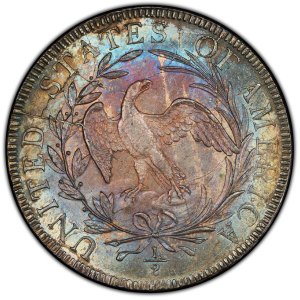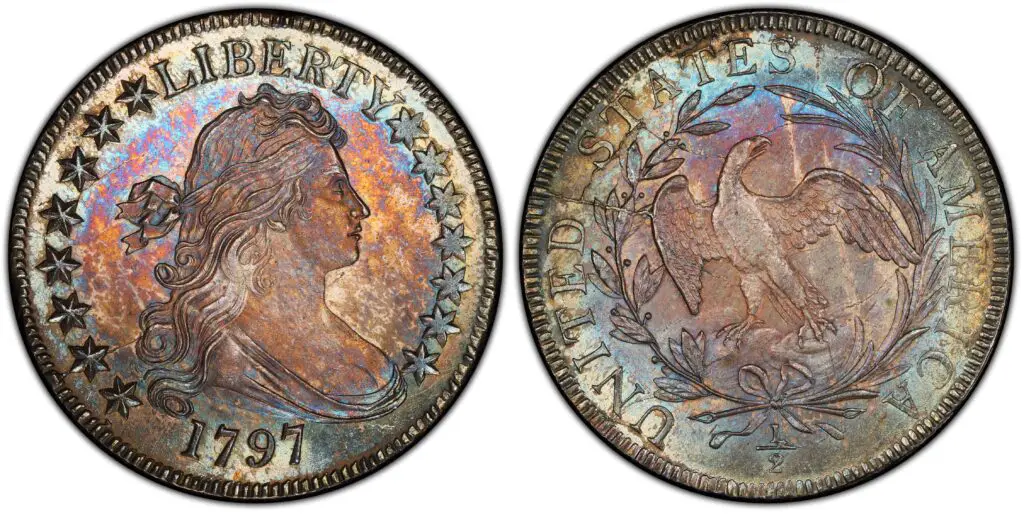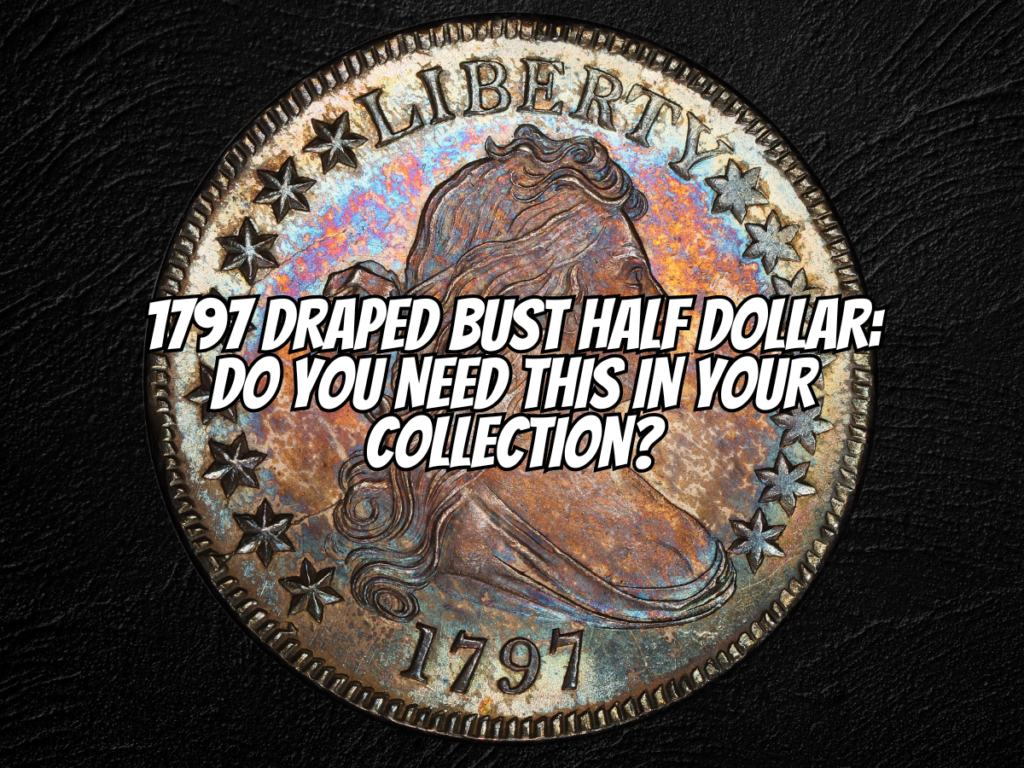The 1797 Draped Bust Half Dollar holds a special place in the hearts of collectors and numismatists, highly desired for its rarity and significance.
This coin is a precious and historic artifact of American history, boasting a distinctive design that mirrors its era.
The 1797 Draped Bust Half Dollar‘s scarcity and value position it as a treasure coveted by many.
Its limited mintage and historical importance contribute to its allure as a prized possession in numerous collections.
Key Takeaways
1. The 1797 Draped Bust Half Dollar is a rare and valuable coin with a rich historical background and unique design.
2. The coin’s design presents Lady Liberty on its front side and a bald eagle on its reverse, rendering it a favored item among collectors.
3. The rarity and value of the coin have made it a highly sought-after addition to many collections, and it has sold for record-breaking prices at auctions.
Historical Background of 1797 Draped Bust Half Dollar
In 1796, the Draped Bust Half Dollar was introduced as a replacement for the Flowing Hair Half Dollar.
The design, created by Robert Scot, who was Chief Engraver at the United States Mint from 1793 to 1823, is displayed on the coin’s obverse.
The obverse portrays the bust of Liberty, elegantly adorned in a flowing dress and a ribbon gracing her hair.
On the reverse side, an eagle with its wings majestically spread is perched upon a cloud and encircled by a wreath.

In 1797, the Draped Bust Half Dollar received slight alterations in its minting process.
The reverse design transitioned from the “small eagle” to the “heraldic eagle” motif, featuring a larger eagle adorned with a shield on its chest and a banner in its beak.
Furthermore, the inscription “E PLURIBUS UNUM” was situated above the eagle on the reverse side.

Produced in Philadelphia, the 1797 Draped Bust Half Dollar is made from 90% silver.
The coin showcases a diameter of 32.5 millimeters and a weight of 13.48 grams.
It features a reeded edge and carries a face value of 50 cents.
The 1797 Draped Bust Half Dollar is regarded as a rare and prized coin, with only a limited number still existing today.
A remarkable instance occurred in January 2023, where a 1797 Draped Bust Half Dollar in MS65+ condition garnered a record-breaking $1,560,000 at an auction held by Heritage Auctions.
Design and Symbolism
Produced between 1796 and 1807, the Draped Bust Half Dollar series includes the 1797 design, which collectors particularly covet.
The coin’s obverse showcases a right-facing portrait of Liberty, her hair gathered in a bow at the nape of her neck.
The word “LIBERTY” is engraved above her image, with the year 1797 below.
On the reverse side, a small eagle is perched on a cloud, encircled by the inscriptions “UNITED STATES OF AMERICA” and “HALF DOLLAR.”
The design of the Draped Bust Half Dollar was crafted by Robert Scot, who also contributed to the creation of several early American coins.
The portrayal of Liberty on the obverse was based on a sketch by Gilbert Stuart, while the reverse eagle design drew from the work of John Eckstein.
The Draped Bust Half Dollar is celebrated for its intricate detailing and meticulous craftsmanship.
The draped bust motif was popular during this era, symbolizing the idea of Liberty shrouded in the American flag.
The eagle on the reverse also held deep patriotic significance, representing the strength and Liberty of the United States.
The 1797 Draped Bust Half Dollar design is an exquisite representation of early American coinage.
Its intricate artistry and meticulous attention to detail render it a sought-after treasure among collectors and historians.
Minting Process in 1797
The inaugural minting of the Draped Bust Half Dollar occurred in 1796 and persisted until 1807.
During 1797, the minting procedure for the Draped Bust Half Dollar retained its similarity to the preceding year’s process.
These coins were made at the Philadelphia Mint, the solitary mint in the United States at that time.
The process began with the preparation of the planchets, or coin blanks.
The planchets were made of silver and were cut to the correct size and weight.
The planchets were then heated and annealed to soften them for striking.
Next, the planchets were loaded into the coining press. The press consisted of two metal dies, one with the obverse (front) design and one with the reverse (back) design.
The planchet was placed between the two dies, and the press was activated to strike the coin.
The striking process was delicate, as too much pressure could cause the planchet to crack or split.
The coins were struck with enough force to impress the design onto the planchet but not so much force as to damage the coin.
Once the coins were struck, they were inspected for quality.
Any coins that did not meet the required standards were melted down and reused in the minting process.
Overall, the minting process for the 1797 Draped Bust Half Dollar was a precise and careful procedure that required skilled workers and specialized equipment.
The resulting coins were beautiful and highly valued for their historical significance and artistic design.
Value and Rarity
Collectors are strongly interested in the 1797 Draped Bust Half Dollar because of its scarcity and historical importance.
Designed by Robert Scot, the coin displays Lady Liberty’s portrait on the front and a bald eagle on the reverse side.
The coin’s value can vary greatly depending on its condition, rarity, and other factors.
According to CoinTrackers.com, the coin’s value in average condition is estimated to be around $48,656, while a mint state coin could be valued at over $1.6 million.
The 1797 Draped Bust Half Dollar’s rarity contributes to its value. Only a limited number of these coins were produced, with a mintage of 2,984.
This makes the coin a rare find and highly sought-after among collectors.
In addition to its rarity and value, the 1797 Draped Bust Half Dollar has historical significance.
The coin was minted during a great change in the United States, as the country was still relatively new and finding its footing.
As such, the coin represents a piece of American history and is highly prized by collectors.
Overall, the 1797 Draped Bust Half Dollar is a valuable and rare coin that holds a special place in American history.
Its value and rarity make it a highly sought-after item among collectors, and its historical significance only adds to its appeal.
Famous Examples and Auction Records

The 1797 Draped Bust Half Dollar is a famous coin among collectors due to its rarity and historical significance.
Over the years, several famous examples of this coin have been sold at auction, fetching millions of dollars.
Here are some of the most notable examples:
- In January 2023, an MS-65+ example was sold for $1,560,000.
- In March 2021, an MS-66 example was sold for $1,680,000.
- In May 2015, an MS-66 example was sold for $1,527,500.
These auctions demonstrate the high demand for this coin among collectors and the astronomical prices it can fetch.
It is worth noting that the 1797 Draped Bust Half Dollar is not only valuable due to its rarity but also due to its historical significance.
Overall, the 1797 Draped Bust Half Dollar is a highly coveted coin among collectors, and its auction records demonstrate its value and importance in the world of numismatics.
The 1797 Draped Bust Half Dollar’s reputation is founded on its limited mintage of 2,984 coins.
This scarcity bestows considerable value upon it within coin collections, with its price range spanning from tens of thousands to over a million dollars for the finest-graded specimens.
Collectors and investors should take note of several variables that impact the value of the 1797 Draped Bust Half Dollar, including its condition, rarity, and historical significance.
Ensuring the authenticity of any purchased coin and verifying its grading through a reputable third-party grading service is imperative.
Before you go…
Overall, the 1797 Draped Bust Half Dollar is a captivating and precious fragment of American history, alluring collectors and investors.
Its rarity and aesthetic appeal make it an enticing acquisition for any collection, while its historical significance solidifies its place in American numismatics for generations to come.
Check out my next article: “Draped Bust Dollar: A Detailed Look.”
Related Articles:

